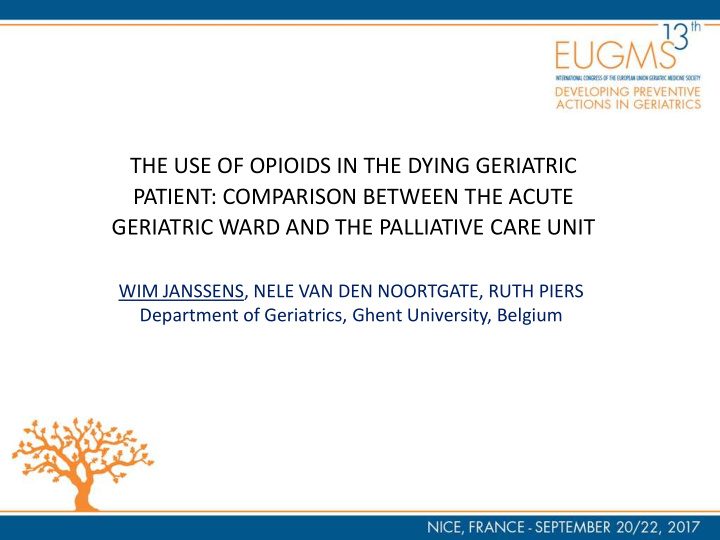



THE USE OF OPIOIDS IN THE DYING GERIATRIC PATIENT: COMPARISON BETWEEN THE ACUTE GERIATRIC WARD AND THE PALLIATIVE CARE UNIT WIM JANSSENS, NELE VAN DEN NOORTGATE, RUTH PIERS Department of Geriatrics, Ghent University, Belgium
CONFLICT OF INTEREST DISCLOSURE I have no potential conflict of interest to report
INTRODUCTION • Many elderly suffer from at least 2 chronic pathologies, leading to a lower proportion of sudden deaths • Elderly people die more often in care facilities • Targeting care on comfort, leads to better quality of life in terminal phase • Little research on qualitative care at the end of life in elderly
• Terminal care mostly developed for cancer patients, who’s death can be foreseen frequently • Geriatric patients’ health deteriorates more gradually, for example when suffering from organ failure or dementia • Shift from life-extending care towards more palliative care is more difficult to determine
• Pain = most frequent and most stressful symptom at the end of life • Opioids = first choice in treating pain • Lack of pain control at the end of life • WHO: increase dose until pain control • Little data concerning use and dosage of opioids in terminal phase in elderly are available
AIM OF THE STUDY • To investigate the differences in use and dosage of opioids in the terminal phase between the acute geriatric unit (AGU) and the palliative care unit (PCU) (i.e. the golden standard)
METHODS • Multi-centric retrospective study • Patients 75 years and older, who died on the ACU and the PCU in 3 hospitals during a 2-years period • Demographic and clinical variables, and data about use and dosage of opioids in the last 72 hours before death • Underlying pathology divided into several groups: cancer, organ failure, dementia, other
RESULTS • 556 patients were included: – 170 in hospital A – 187 in hospital B – 199 in hospital C • Mean age 84.2 (range 75-102) • 214 (38,5%) died on PCU, 342 (61,5%) died on AGU • People on the AGU are older compared to those on the PCU • Most frequent main pathology was cancer on the PCU and organ failure on the AGU
Table 1: Patient characteristics (n = 556) Patient characteristics Total Acute geriatric unit Palliative care unit p-value Number 566 342 214 Hospital Hospital A 170 100 70 department Hospital B 187 93 94 Hospital C 199 149 50 Gender Male 251 142 (41,5%) 109 (50.9%) Female 305 200 (58.5%) 105 (49.1%) Mean age 84.2 85.2 82.7 Age category 75 – 79 122 58 (17.0%) 64 (29.9%) <0.001 80 – 84 177 106 (31.0%) 71 (33.2%) 85 – 89 164 101 (29.5%) 63 (29.4%) 90+ 93 77 (22.5%) 16 (7.5%) Main pathology Cancer 254 71 (20.8%) 183 (85.5%) <0.001 Organ failure 210 197 (57.6%) 13 (6.1%) Dementia 38 36 (10.5%) 2 (0.9%) Other 54 38 (11.1%) 16 (7.5%)
Use of opioids - 84,2% received opioids (p<0.001): - 75.5% on AGU Total Opioids = no Opioids = yes p-value - 98.2% on PCU (n = 88) (n = 468) Department AGU 342 84 (24.5%) 258 (75.5%) <0.001 PCU 214 4 (1.8%) 210 (98.2%) Hospital Hospital A 170 36 (21.2%) 134 (78.8%) <0.001 Hospital B 187 4 (2.1%) 183 (97.9%) Hospital C 199 48 (24.1%) 151 (75.9%)
Logistic regression (Nagelkerke R Square 31%) - Opioids vs no opioids - Hospital and department had a OR 95% for OR Sig. significant influence on Lower Upper whether or not the patients received opioids - In hospital B, patients were 11 Gender 1,076 ,634 1,826 ,786 times more likely to receive opioids compared to hospital C Age category ,181 - Patients admitted to the PCU were 11 times more likely to be Hospital (B vs C) 11,713 4,046 33,904 ,000 treated with opioids compared to the AGU Cancer yes/no ,763 ,406 1,432 ,399 - Having cancer or not did not influence the possibility of Department (PCU vs 11,518 3,822 34,709 ,000 being treated with opioids AGU)
Multivariate linear regression analysis on the patients that received opioids (n = 468) - Patients receiving opioids Parameter B 95% Confidence Interval Sig. (n = 468) Lower Bound Upper Bound - Dosage is dependent on: Gender (female vs male) -3,621 -17,944 10,702 ,620 - department (higher dosage on PCU compared to AGU), Age category (75-79 vs 90+) 17,169 -6,743 41,080 ,159 - hospital (higher dosage in Age category (80-84 vs 90+) 15,932 -6,550 38,415 ,164 hospital A and B compared to hospital C) and Age category (85-89 vs 90+) 18,611 -4,074 41,296 ,108 - whether patients had cancer Department (PCU vs AGU) 28,340 9,704 46,975 ,003 or not (lower dosage when patients did not suffer from Hospital (A vs C) 36,111 17,854 54,367 ,000 cancer) Hospital (B vs C) 18,125 1,124 35,125 ,037 Cancer (no vs yes) -27,429 -45,494 -9,363 ,003
CONCLUSIONS • Organ failure is more frequently considered as the underlying pathology in elderly dying on an AGU, compared to cancer on a PCU • High frequency of use of opioids in terminal phase • Receiving opioids was influenced by hospital and department, not by suffering from cancer or not • Dosage of opioids was dependent on department, hospital, whether patients suffered from cancer or not
Recommend
More recommend